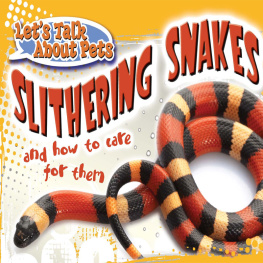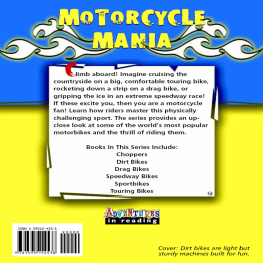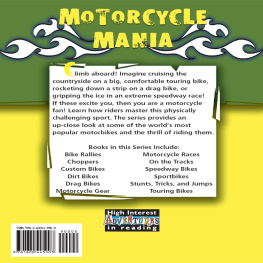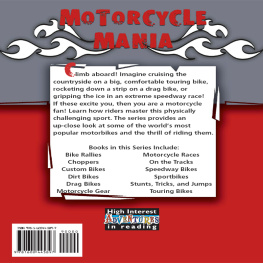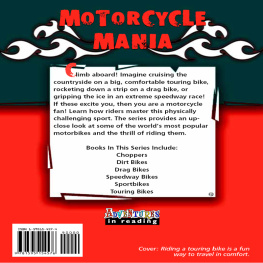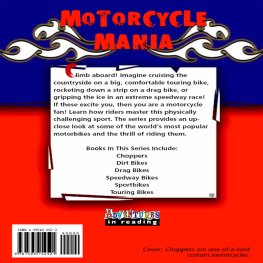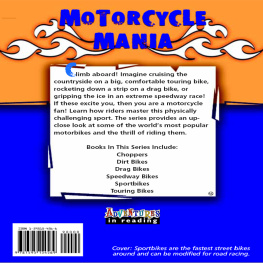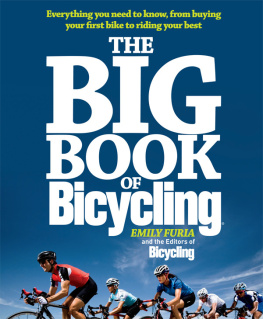Table of Contents
Guide
WEBSITES TO VISIT
www.amadirectlink.com
www.msf-usa.org
ABOUT THE AUTHORS
David and Patricia Armentrout specialize in writing nonfiction books for young readers. They have had several books published for primary school reading. The Armentrouts live in Cincinnati, Ohio, with their two children.
CYCLE GEAR
There are motorcycles designed for high-speed racing, and some for long distance touring. Some motorcycles are meant for paved surfaces and others for rough off-road trails. Its no surprise then, that cycle gear, equipment, and accessories are also designed for every kind of motorcycle and for every riding style.

Motorcycle racers wear tight-fitting, protective leather suits.
SAFETY FIRST
To many, motorcycling is more than a form of transportation; its a fun motor sport. But riding on two wheels is riskier than on four. Thats why safety gear is a must.

Riders maneuver to avoid an unlucky racer.
The helmet is the most important piece of safety gear. It protects the head during impact, reducing injuries and deaths.

A helmet, gloves, and ear plugs protect riders.
HEADS UP
Full face helmets provide the best protection. They cover the entire skull and chin and have a protective face shield. Open face helmets cover the skull but dont offer chin protection. A half helmet, also called a shorty, doesnt cover or protect the lower rear part of the skull. Half helmets also come off easier upon impact.
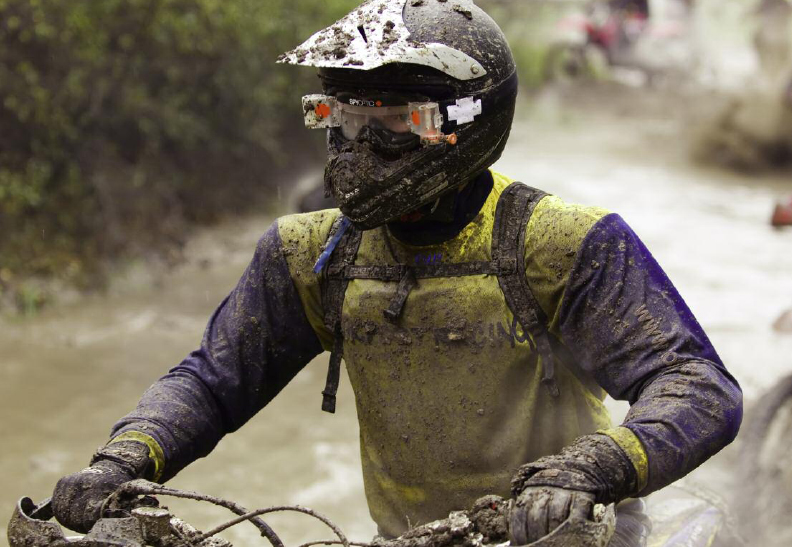
Goggles protect enduro riders from flying dirt and mud.

This shorty helmet has a nice design but it doesn't provide the best protection.
Bikers usually wear a clear or tinted face shield, goggles, or wraparound sunglasses when riding.
LEATHERS
Leathers are the clothes worn by motorcyclists. Leathers fit tight so they cant get caught on anything. Black leather jackets and pants are traditional pieces worn by bikers. And while the biker look is popular, leathers are really about safety. Riding gear is constructed from heavy weight leather that protects against skin abrasions and puncture wounds resulting from a fall.

A touring motorcyclist is dressed from head to toe in protective gear.

Experienced riders know how important protective gear is.
in the shoulders, spine, elbows, and knees. No racer would want to take a spill without body armor.

Racing leathers combine natural leather, synthetic fabrics, and hard plastic armor.

A motocross racer wears extra armor on his chest and shoulders.
GLOVES AND BOOTS
Leather gloves and boots provide comfort and protection. Boots should cover the ankles, and have slip resistant soles with heels that grip the bikes footpegs.

Gloves offer protection and improve grip.

Leather boots protect the foot and ankle, while hard plastic "sliders" protect the knees.
There are a variety of racing boots to choose from. racers wear a metal plate on their left boot. The plate keeps the boot from wearing away as riders drag their foot into the turns.
JUST FOR BIKES
Motorcyclists equip their bikes with safety gear, too. panels and windshields, protect riders from wind, airborne debris, and rain. They are common on sport and touring bikes. Fairings are sold as aftermarket parts too, so they can be added to bikes that dont have them.

Italian Highway Police motorcycles have windshields, body panels, and rear luggage compartments.

Body panels that cover the engine are called cowlings.
Most racers use a trailer to transport their bikes. A bike stand, tools, and spare bike parts also come in handy.
LUGGAGE
The biker term for motorcycle storage is luggage. Some bikes have built-in hard luggage mounted on each side of the rear wheel. Motorcycles can also be fitted with luggage racks and soft luggage, including tank bags, seat or saddlebags, and tail packs. Luggage is great for storing helmets, rain gear, and bike covers when theyre not in use.

Leather saddlebags are stylish and functional.

A large rear luggage compartment can hold two helmets and has a little extra space.
Horns, mirrors, foot pegs, gas caps, seats, sissy bars, and crash bars can be added or changed on most motorcycles. Accessories like these really personalize a bike.
GRIPPING THE ROAD
The helmet may be the riders most important piece of safety gear, but the tires will make or break the bike. The right motorcycle tires provide the best handling and the safest ride.
| MOTORCYCLE TYPE | TIRE NEEDS |
Cruiser | hard rubber, various tread patterns
operate well at all temperature cycles |
Touring bike | hard rubber with treads
stable, long lasting, all season |
Racer | soft rubber
get hot and sticky from use, grip well |
Dragster | soft rubber
get hot and sticky from use, grip well |
Trail/Dirt bike |


